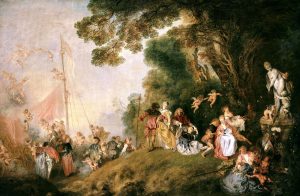Jean-Antoine Watteau, Pilgrimage to Cythera
Toward the end of the seventeenth century, a dispute arose among the members of the French Academy, who then formed two factions: the Poussinistes against the Rubenistes. The conservatives defended Poussin’s view that drawing, which appealed to the mind, was superior to color, which appealed to the senses The Rubenistes favored color, rather than drawing, as being truer to nature. The also pointed out that drawing, admittedly based on reason, appeals only to the expert few, whereas color appeals to everyone.

The greatest of the Rubenistes was Jean-Antoine Watteau (1684-1721). He was a significant contributor to the new Rococo style as well as to the new subjects associated with it. His painted visions of fantasy show idyllic images of aristocratic life, with elegant figures luxuriously dressed in shimmering pastel colors and set in dreamlike outdoor settings. Because Watteau’s fantasies had little historical or mythological basis, his paintings broke many academic rules and did not conform to any established category. To admit Watteau as a member and accept his romantic paintings, the French Academy created the new classification of painting called fêtes galantes (meaning “elegant fêtes” or “outdoor entertainments.”) The premier category was history painting, considered to be the highest form of art because it was thought to require the most imagination and was therefore the most difficult to execute. Next were portraits, landscapes, and then still life.
Watteau’s reception piece for the Academy, A Pilgrimage to Cythera, is an evocation of love and includes elements of Classical mythology. Cythera, which came to be viewed as an island of love, was one of the settings for the Greek myth of the birth of Venus, who rose from the foam of the sea. It is unclear whether the couples are arriving at or leaving the island. What is certain is that Watteau has created a delightful yet slightly melancholic setting of love, where the couples may enjoy a melding of human passions and nature in privacy and freedom. The action unfolds in the foreground from right to left like a continuous narrative, which suggests that the figures may be about the board the boat. Two lovers remain engaged in their amorous tryst; behind them, another couple rises to follow a third pair down the hill as the reluctant young woman casts a longing look back at the goddess’ sacred grove. Young couples, accompanied by swarms of cupids, pay homage to Venus, whose garlanded sculpture appears on the far right. The delicate colors – pale greens, blues, pinks and roses – suggest the gentle nature of the lovers’ relationship.[1]
- Penelope J.E. Davies, et. al. Janson’s History of Art: The Western Tradition, (Upper Saddle River, NJ: Pearson, 2007), 759. ↵

